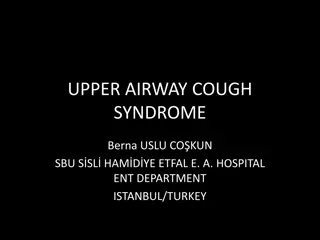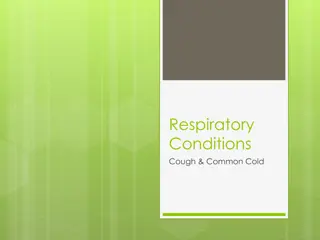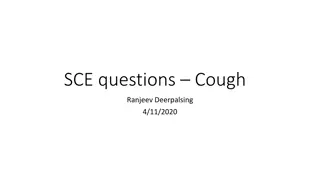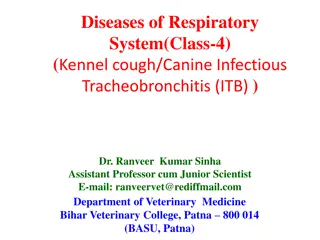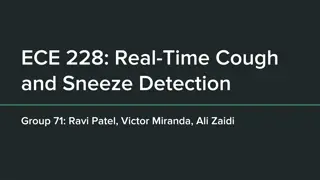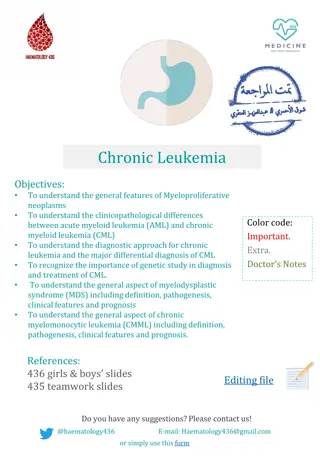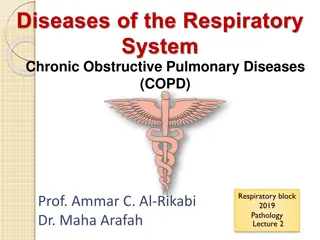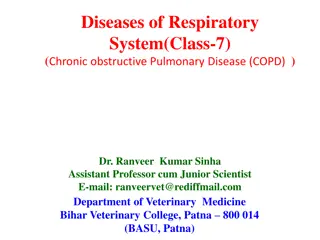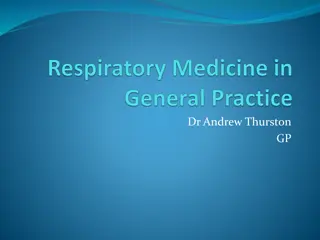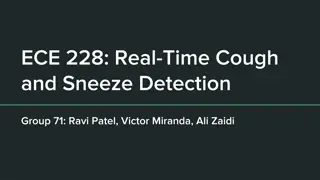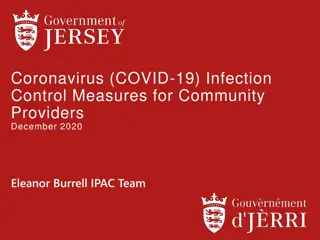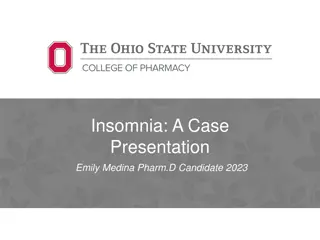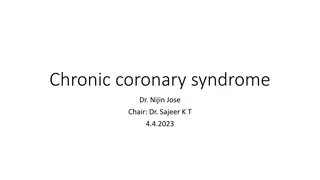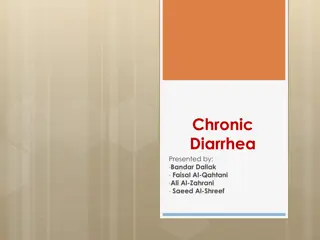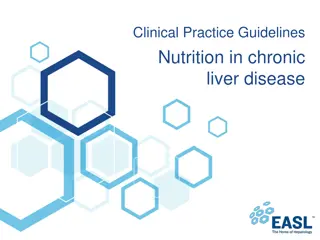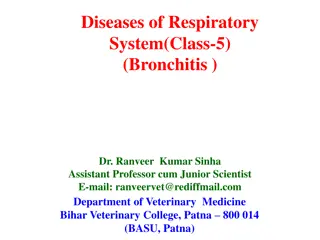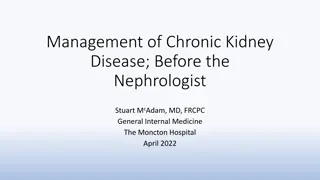Understanding Chronic Cough: Case Study and Assessment
30-year-old L.B., a secretary, presents with a dry, hacking cough and shortness of breath post-bronchitis recovery. History of asthma in family raises concerns. Intake nurse must acquire vital signs, medical history, symptoms, and potential triggers to determine the underlying cause of the chronic cough.
Download Presentation

Please find below an Image/Link to download the presentation.
The content on the website is provided AS IS for your information and personal use only. It may not be sold, licensed, or shared on other websites without obtaining consent from the author. Download presentation by click this link. If you encounter any issues during the download, it is possible that the publisher has removed the file from their server.
E N D
Presentation Transcript
Case Study ASTHMA ARNP, BSN EDUVIGES M PUENTES FUNDAMENTAL OF NURSING NUR319
Scenario L.B. is a 30-year-old secretary who is seen with 6 weeks of a dry, hacking cough after recovering from bronchitis this winter. The cough is worse at night and associated with shortness of breath (SOB). In the past she has experienced coughing spells after running a 5K race. She does have hay fever that seems to be year-round and has eczema in the winter. Both of her children and her maternal grandmother have asthma.
1. As the intake nurse working in the clinic, what routine information would you want to obtain from L.B.? Answer VS, including oximetry Personal and family history Medications Allergies, skin conditions Description of her symptoms: location, quality, quantity, timing, setting, factors that aggravate or relieve, associated symptoms Whether she ever experienced these symptoms before
2. L.B.s chief complaint (C/C) is a cough. What are the main causes of chronic cough, and what questions should you ask to elicit information about each cause? Answer Is the heartburn worse after you eat certain foods or beverages, go to bed within 4 hours of eating a meal, exercise too soon after eating, or overeat? How often do you take antacids or some type of stomach medication? Do the antacids help your cough? Smoking: Have you ever smoked? Do you currently smoke? How many packs did you smoke, and how many years have you smoked? Chronic bronchitis: How long have you had this cough? Do you cough up anything? Have you had a productive cough at least 3 months of the year for 2 consecutive years? Medication induced: What medications do you take? Did your cough begin after starting any medication? Post respiratory infection: Did your cough begin during a respiratory infection? Asthma: Do you have chronic drainage down the back of your throat? Do you have a history of asthma? Do you have a tickle in your throat? Do you ever experience musical breathing or wheezing? Do you clear your throat a lot? Do you experience chest tightness or SOB? GERD: Is your cough brought on by exercising, high pollen counts, cold air, laughing, or illness? Do you experience acid refl ux (does stomach acid come up into your throat)? Postnasal drip: Do you have allergies or sinus problems?
3. What would you include in your physical examination and why? Answer VS: Carefully note respiratory effort, respiratory rate, and oximetry. ENT: There is a close correlation between asthma and allergic rhinitis; inadequately controlled allergic rhinitis correlates with uncontrolled asthma. Findings for allergic rhinitis are pale, boggy turbinates and serous otitis with or without mucous drainage in the posterior pharynx. Lung sounds: Often wheezing is heard, but breath sounds may be clear; if the patient s airways are very constricted, treatment with a beta agonist may relax the airways enough to hear wheezing. Patients with COPD often have distant breath sounds; patients with pneumonia may have crackles, wheezes, and egophony. Abdominal palpation: Look for gastric tenderness that often accompanies GERD. GERD is another trigger for asthma. L.B. reported increased cough at night. Skin: Eczema can be an atopic manifestation of asthma.
CASE STUDY PROGRESS L.B. was not in acute distress. Vital signs (VS) were 110/60, 55, 18, peak fl ow at 350 L/min with good effort \3. Expected peak fl ow for her height and age was 512 L/min, so her response is 68% of predicted. She had no sinus tenderness, ears were negative, nasal mucosa was pale and boggy, mouth was negative, there was no cervical adenopathy, lungs were clear to auscultation (CTA), but forced expiration using the peak fl ow meter (PFM) seemed to generate a cough. Abdomen was soft and nontender. Skin was dry, and hands were erythematous in the web spaces but had no infl ammation in the antecubital, trapezius, or popliteal areas (common location of adult eczema).
4. The provider orders a predilator and postdilator pulmonary function test (PFT). What is the purpose of completing the PFTs predilator and postdilator? Answer PFTs are performed initially, then 5 minutes after inhalation of a beta agonist. This is called a pre-post dilator study and is meant to determine whether a person has asthma. If L.B. has asthma, the post dilator maneuver will show more than 15% improvement in airflow.
5. The diagnosis of asthma is confirmed, and L.B. returns to the clinic for asthma education. What topics should you address? Answer Understand that asthma is a controllable disease. Explain what each medication is and why she is taking it. Demonstrate PFM and MDI technique and ask for a return demonstration. Keep a journal to identify and treat triggers. The patient needs to track seasonal symptoms and symptoms related to temperature, humidity, dust, animal dander, pollen, perfume, etc. Once the patient is aware of the diagnosis, the triggers become more evident. Make certain she has a written plan to treat exacerbations and knows when to seek emergency assistance.
6. What is a PFM, and what is the purpose of the peak expiratory fl ow rate (PEFR) measurement? Answer PFM is a hand-held device that measures the maximum fl ow rate that can be generated when an individual takes a maximum inspiration then expels the volume with a maximum expiratory effort through the PFM device. The PEFR, measured in liters per minute, indicates the presence or absence of airfl ow obstruction. Normal PEFRs are based on height, age, and gender. A decreased PEFR indicates airway obstruction. The maneuver requires a consistent maximal effort on the part of the individual being tested.
Instructor Note: Despite the criticism that PEFR is effort dependent, it can be used to monitor the effect of medication and can detect a worsening condition before symptoms are apparent to the individual. PEFR should be completed bid before and after inhaled medications for 2 weeks to develop a personal best or goal. The provider calculates 80% and 50% of the patient s personal best and marks the meter with a green zone (which equals 80% to 100% of the personal best), yellow zone (50% to 79%), and red zone (below 50%). Readings in the green zone indicate the patient is OK and may continue with daily activities. Readings in the yellow zone indicate the patient is having a moderate asthma attack and should follow the plan for increasing the flow rate to the green zone. Readings in the red zone indicate the patient is having a severe asthma attack and should seek immediate medical assistance. It is important that each patient have a care plan to address what to do if the readings fall in the yellow or red zones. The PFM is as important to the control of asthma as a glucometer is to the control of diabetes.
7. Give L.B. precise instructions to perform the PFM maneuver. Answer Breathe in as deeply as you can, place the PFM in your mouth, and blow as hard and fast as you can, then record the reading. Repeat 2 times for a total of 3 measurements. Remembering that the PFM reading is effort dependent, it is important for the readings to be within 5% of each other. If one reading is much smaller than the other two, it should be discarded and another reading taken.
8. The provider ordered triamcinolone (Azmacort) 2 puffs bid and albuterol 2 puffs q6h prn. What points should you include when teaching L.B. about her medications? Answer Asthma is an inflammatory disease, and triamcinolone is an anti-inflammatory drug. The goal of treatment for mild asthma is to identify triggers, control inflammation with an anti-inflammatory, and control secondary wheezing with a beta2 agonist (albuterol). Albuterol is a bronchodilator that relaxes smooth muscles around the large airways. The albuterol MDI has fewer side effects than oral medication, but she may experience some anxiety, heart palpitations, or slight tremors. These symptoms can be worse if the MDI is not used correctly.
9. You instruct L.B. in the proper use of the MDI using a spacer. How would you explain proper MDI use? Answer Remove the protective cap from the inhaler, shake well, and insert the inhaler into the back of the spacer. Breathe out normally, put the opening of the spacer in your mouth, and close your lips around it. Spray 1 puff into the spacer, then slowly breathe in as deeply as you can over a period of 3 or 4 seconds (the spacer will whistle or make a musical sound if you breathe in too quickly). Remove the spacer from your mouth and hold your breath for 10 seconds, then exhale. Wait 1 minute between puffs.


